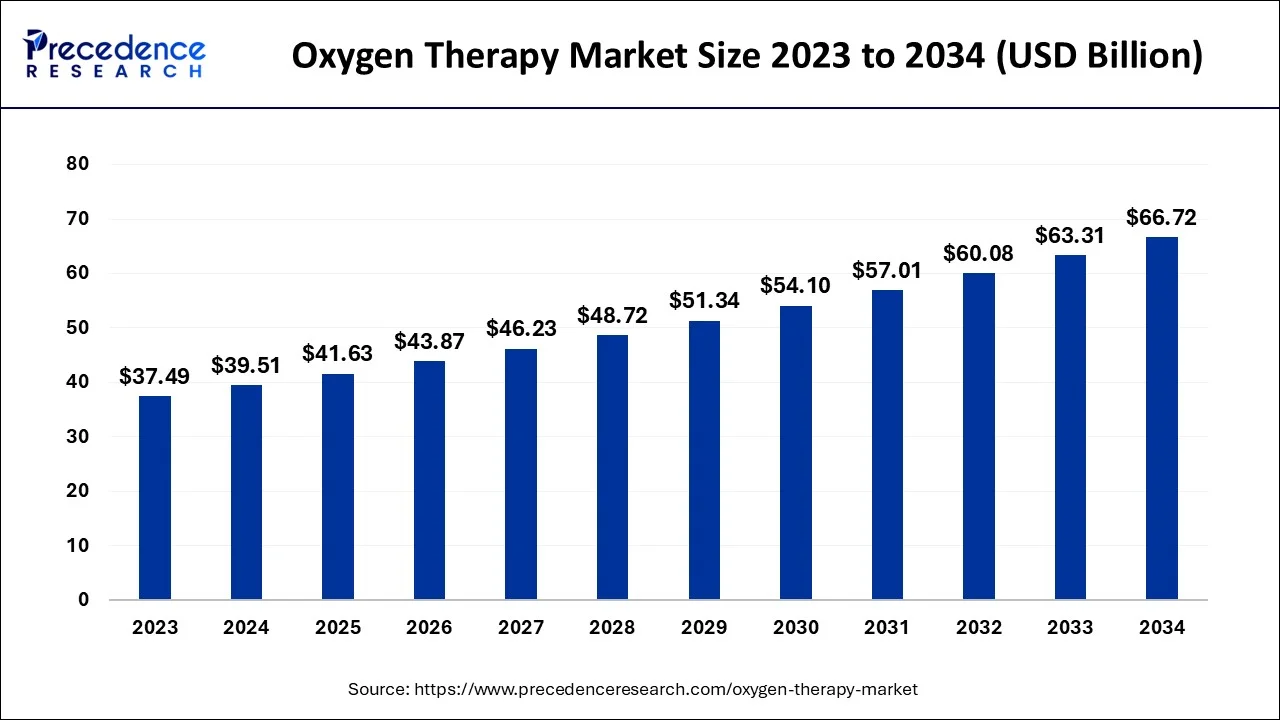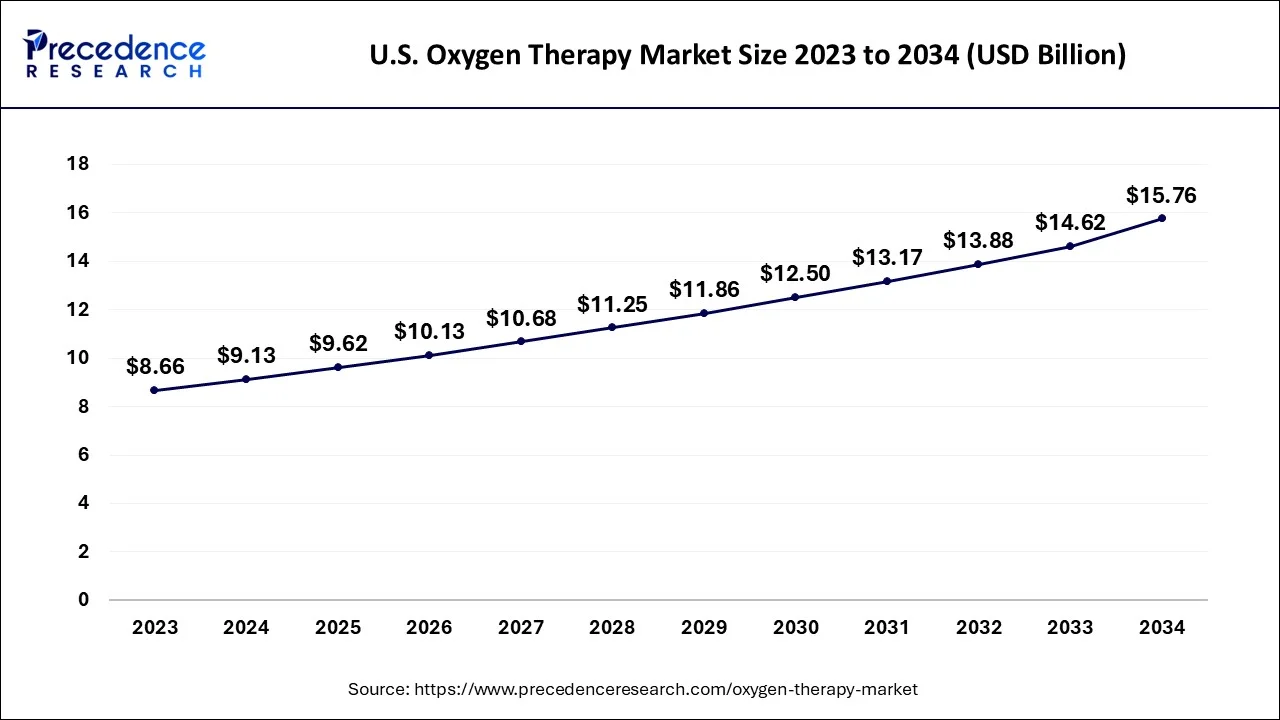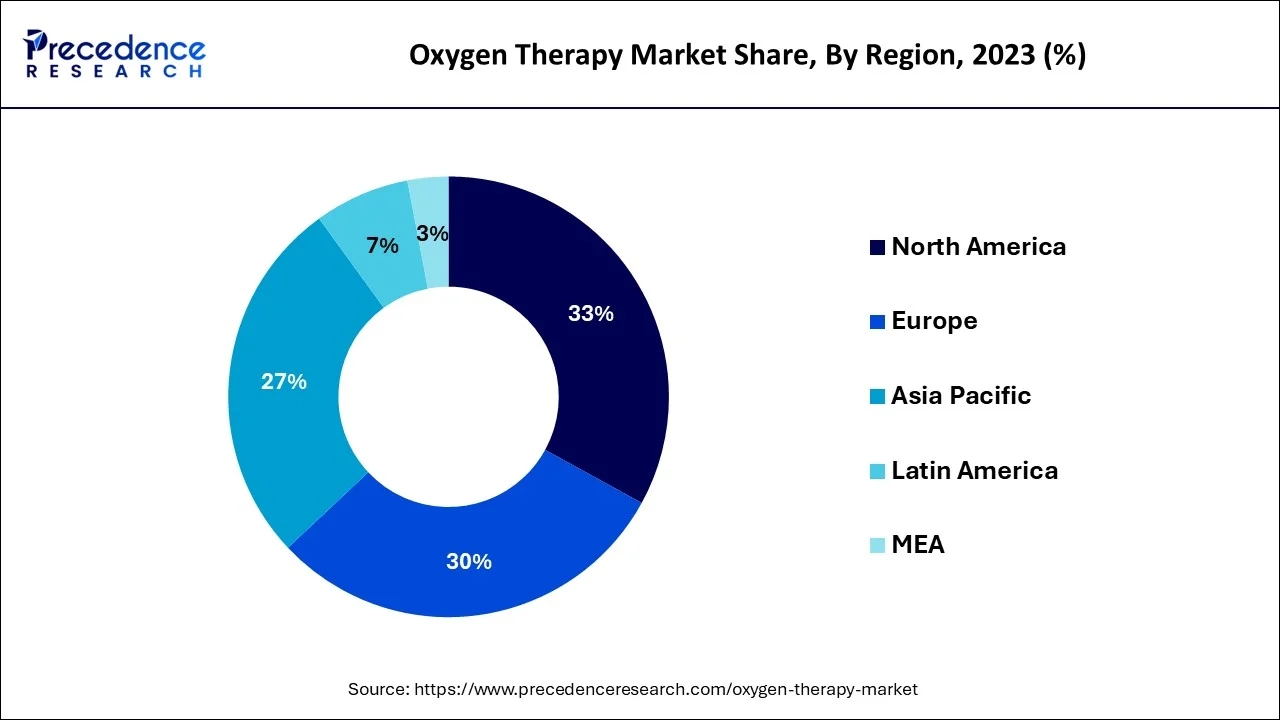January 2025
The global oxygen therapy market size accounted for USD 39.51 billion in 2024, grew to USD 41.63 billion in 2025 and is predicted to surpass around USD 66.72 billion by 2034, representing a healthy CAGR of 5.38% between 2024 and 2034. The North America oxygen therapy market size is calculated at USD 13.04 billion in 2024 and is expected to grow at a fastest CAGR of 5.53% during the forecast year.
The global oxygen therapy market size is estimated at USD 39.51 billion in 2024 and is anticipated to reach around USD 66.72 billion by 2034, expanding at a CAGR of 5.38% from 2024 to 2034.

Oxygen therapy is used for the treatment of both acute and chronic illnesses such as chronic obstructive pulmonary disease (COPD), pneumonia, and asthma. This therapy helps maintain the blood's oxygen level. People with COPD often benefit from long-term oxygen therapy. Cystic fibrosis, dysplasia, heart failure, sleep apnea, and lung abnormalities are a few other acute or chronic medical conditions when oxygen therapy is helpful. Some individuals only require it temporarily, and some need ongoing oxygen therapy.
The U.S. oxygen therapy market size is estimated at USD 9.13 billion in 2024 and is expected to be worth around USD 15.76 billion by 2034, rising at a CAGR of 5.59% from 2024 to 2034.

With a revenue share of over 33% in 2023, North America dominated the market thanks to extensive O2 treatment research and development activities. For instance, the British Medical Research Council and North American Nocturnal Oxygen Therapy conducted studies to determine the efficacy of long-term O2 therapy.
The increasing use of topical wound oxygen therapy (TWO) and hyperbaric oxygen therapy in this region also impact market demand. Due to urbanization and occupational risks, this region also has a higher risk of developing respiratory illnesses, which is anticipated to spur market growth throughout the projection period.

During the forecast period, Asia Pacific is projected to have exponential growth. High R&D spending by international manufacturers and the rising commercialization of O2 therapy devices created by these firms are the market's primary drivers. Additionally, throughout the projected period, the firm is expected to benefit from lucrative growth potential due to the urgent need to create new technologies and replace and update medical infrastructure.
Ongoing technological advancements, growing international collaboration and expanding distribution networks fuel the development of O2 therapy in this area.
The main drivers of the market are the rising incidence of persistent respiratory disorders and the rising demand for home healthcare. Nearly 12 million adult Americans have been diagnosed with COPD, and 120,000 people die from it each year, according to the National Institutes of Health (NIH). The market for these goods is anticipated to increase as the patient population grows. In the ensuing years, the sector is expected to be driven by this subsequent rise in demand.
| Report Coverage | Details |
| Market Size in 2024 | USD 39.51 Billion |
| Market Size by 2034 | USD 66.72 Billion |
| Growth Rate from 2024 to 2034 | CAGR of 5.38% |
| Largest Market | North America |
| Base Year | 2023 |
| Forecast Period | 2024 to 2034 |
| Segments Covered | By Product, By Portability and By Application |
| Regions Covered | North America, Europe, Asia-Pacific, Latin America and Middle East & Africa |
The surge in the latest oxygen therapy solutions
The demand for the most minor, durable portable oxygen solutions is rising. Patients are less likely to adhere to their therapy using portable home oxygen therapy equipment because they prefer to avoid carrying around a heavy, cumbersome oxygen device. However, the improvement of battery life is one of the areas where there have been considerable advancements in oxygen-conserving methods and lithium-ion battery technology in recent years.
The most recent versions of portable oxygen concentrators weigh just 5-7 pounds and, depending on the litre flow settings chosen by each patient, can provide oxygen therapy for up to 8–13 hours after a battery charge.
Manufacturers of portable oxygen concentrators are also aiming for silent compressor motors, which would reduce noise pollution in small places. The most effective use of dosing technology has allowed portable oxygen concentrator manufacturers to improve performance features, enabling more current designs to increase the units' lifespan beyond occasional use and become dependable and durable for a consistent five-year cycle.
Frequent adverse effects:
The market expansion for oxygen treatment is being constrained by their unfavorable side effects, which, when used therapeutically, include skin irritation and nasal dryness. Dryness of the nose and skin irritation are two of the most typical side effects of oxygen therapy. The cannula may rub against the skin and create irritation.
The nasal passages are dried out by oxygen therapy, which increases the risk of nasal dryness and nosebleeds. Oxygen toxicity, brought by inappropriate or excessive supplemental oxygen, can seriously harm the lungs and other organ systems. Long-term exposure to high oxygen concentrations can enhance free radical production and cause lung injury.
The range of lung ailments it can induce includes minor tracheobronchitis and widespread alveolar damage. As a result, this may hinder the expansion of the oxygen therapy market.
Technology advancements in therapeutic equipment:
Due to the increase in individuals with respiratory conditions who practically need oxygen therapy devices (OTD), the pressure on healthcare facilities to handle patients who need OTD constantly is fueling the market for oxygen therapy. As wearable technology develops with improvements in Photoplethysmography (PPG) sensors and wireless 5G connectivity, it is anticipated that the trend of digital health data transfer for oxygen therapy monitoring will increase rapidly.
PPG is a non-invasive device that measures volumetric fluctuations in blood circulation by using a light source and a photodetector at the skin's surface. Only specific body parts, including the fingertips, earlobes, and forehead, can accommodate wearable PPG sensors. Additionally, patients can become more involved in the success of their care with the rising use and adoption of remote patient monitoring systems and the proper instruction in their use. The aforementioned aspects will give the market profitable prospects.
Due to its high availability and utilization in the form of O2 concentrators, compressed gas systems, cylinders, and liquid oxygen, oxygen source equipment made up the highest percentage in 2023. Additionally, these devices serve as the primary source and first step in O2 therapy, playing a crucial role in the industry's overall growth.
The oxygen concentrators segment of the oxygen source equipment market is anticipated to grow profitably. Transportable concentrators are expected to have a high growth potential due to their use in ambulances, trains, and aeroplanes, as well as their application in various medical emergencies, which will support this segment's potential demand.
Over the next few years, it is anticipated that demand will increase due to the growing acceptance and popularity of on-demand & continuous Portable Oxygen Concentrators (POC) in various applications, including emergency medicine. This increase is linked to the entry of international rivals, consumer desire for portable technology, and the urgent clinical need for more mobility support for the senior population. The firm is expected to grow due to ongoing innovation, which produces more effective units and lower prices.
Due to the accessibility of various delivery methods tailored to different patients' physiological and inspiratory needs, the oxygen delivery devices market is predicted to grow at a profitable rate. In the upcoming years, demand is anticipated to be aided by prospective benefits such as consistent O2 flow, variable pressure, exclusion of complicated masks, and flow dilution.
The stationary oxygen therapy equipment devices category is predicted to lead the market in portability during the study period. Because most patients receiving treatment are confined to beds, the fixed oxygen therapy equipment market is driven and will account for maximum market revenue during the projection period.
Due to a rising population base, favorable reimbursement policies, and a low mobility profile, this category is expanding. Long-term oxygen therapy (LTOT) equipment used in residential settings is expected to enhance demand for oxygen therapy equipment over the projected period.
Due to the rising prevalence of COPD, the chronic obstructive pulmonary disorder (COPD) segment will hold a share of about 36% in 2022. According to the WHO, COPD affects about 65 million people worldwide and is the third most significant cause of death. The clinical need for COPD treatment is driven by the disease's increasing prevalence, which is helping the industry grow.
By Product
By Portability
By Application
By Geography
For inquiries regarding discounts, bulk purchases, or customization requests, please contact us at sales@precedenceresearch.com
No cookie-cutter, only authentic analysis – take the 1st step to become a Precedence Research client
January 2025
November 2024
October 2024
June 2024